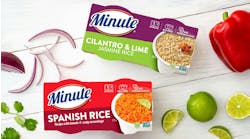When Uplift Food founder Kara Landau was developing her company’s products, she wanted to include a diversity of fibers that would improve her customers’ health. At the same time, she needed to ensure that the mouthfeel and texture of her cookies, puffs and bites was just right.
“Uplift Food sources a variety of powdered and wholefood sources of fiber, which are made up of different kinds of fibers, such as soluble and insoluble fiber, together with resistant starch." Landau explains. "The fibers selected in Uplifts products offer a blend of types of fiber while also providing different sources of prebiotics to ensure maximum diversity is maintained."
Landau’s work to create healthy snacks with desirable textural characteristics illustrates the two-sided nature of fiber ingredients: They can be used to increase the better-for-you aspects of a product, and they are functional ingredients that can alter other characteristics of a processed food product.
“Some of them may also have useful binding properties," she continues. "Perhaps most importantly from a consumer-facing standpoint, fibers can also serve to increase the volume of a product, thereby allowing food producers to reduce the calorie count per serving or increase the serving size for the same amount of calories.”
Adding health
Increasing fiber content has long been a key strategy for making a product healthier. Melendez-Klinger notes that American adults only get about 15g of fiber per day, which is half the 25-30g recommended by the American Heart Assn. So adding fiber provides a health advantage.
But not all fiber is created equal, a fact that the FDA made clear when it released its formal definition of dietary fiber in 2016. The FDA identified two classes of fiber: naturally occurring fibers that are “intrinsic and intact” in plants and “isolated or synthetic non-digestible carbohydrates (with 3 or more monomeric units) determined by FDA to have physiological effects that are beneficial to human health.”
The first category – naturally occurring fibers – are probably what most consumers think of when they consider the fiber content in food. For example, whole wheat bread – not to be confused with simply “wheat” bread – contains the bran of the wheat kernel, which is the outer layer rich in fiber, and can be labeled as containing fiber.
Similarly, if a product contains fiber from fruits or vegetables, it falls into that category. Landau, for example, includes green banana flour and lupini bean flour in some of her products, and the fiber in those flours is considered naturally occurring because it has not been isolated from the plant itself.
According to the FDA, “foods containing these fibers have been shown to be beneficial, and manufacturers do not need to demonstrate that they provide beneficial physiological effects to human health.”
The company recently released a consumer product, Flourish Flour, based on this ingredient, but it also provides it to other food processors.
“Since launching HealthSense three years ago, we’ve continued to see increased adoption among national consumer packaged goods companies who share a commitment to better health,” says Katie Harris, senior product developer and nutrition scientist at Bay State Milling.
“These products have ranged from pizza, pasta, tortillas and even indulgent categories from companies like Sun Noodle Company (Spicy Ramen Noodles), Golden Home Bakery Products (Ultra Thin Pizza Crust), Pastabilities (Good Day Pasta & Mighty Pasta) and Enlightened (Sugar Free Ice Cream Cones)," she continues. "Most recently, Flourish has been used in baked goods at the Boston-based bakery Mamaleh’s, in their Banana-Halva Chocolate Chip Muffin & Tahini Cookies.”
Fiber in the FDA’s other approved category – isolated or synthetic – is not necessarily less nutritious than naturally occurring fiber. It’s just not an intact part of a plant. Some of the fibers in this category are guar gum, pectin, locust bean gum, psyllium husk and beta-glucan soluble fiber.
Another fiber in that category is inulin, which is made from chicory root. The fiber has a host of nutritional benefits.
“I am particularly excited about inulin, which offers many benefits when added to both foods – for example Greek yogurt or beverages, most commonly through drink powders,” Melendez-Klinger says. “While research on inulin has linked it to diverse benefits, some of the most common are improvements in digestive health, managing diabetes, aiding in weight loss.”
The reason inulin and several other fibers – including beta glucan resistant starches – have these benefits is because they pass through the small intestine and ferment in the large bowel, where they produce short chain fatty acids (SCFA).
“The acidity neutralizes the ammonia produced with a high-protein/meat diet, and helps to lower colonic pH,” explains Julie Miller Jones, emeritus professor of nutrition at St. Catherine University in St. Paul, Minn. and a member of the Grain Foods Foundation’s Scientific Advisory Board. “This not only promotes growth of beneficial bacteria, but also is associated with lower colon cancer risk. SCFAs also are beneficial in helping to effect satiety and control cholesterol and blood glucose.”
The fact that inulin promotes the growth of beneficial bacteria is why it is often called a prebiotic. Companies that add inulin to processed food often promote that claim. For example, Danone North America uses inulin in its Horizon Organic Growing Years dairy products.
“The transition from formula or breast milk to cow’s milk and/or other dairy products can be a challenge for parents, as many worry their children won’t get the proper nutrition they need,” says Miguel Freitas, vice president of scientific affairs at Danone North America. "When Danone was developing the Horizon Organic Growing Years product line, we worked directly alongside pediatricians who recommended we formulate the products with prebiotics as an added nutritional benefit.
"Our pediatrician partners recommended us to use chicory root fiber (inulin) as the prebiotic source in the Growing Years line of products. Prebiotics such as inulin help feed good bacteria in the gut.”
When it comes to a fiber’s nutritional value in a processed food, the FDA category it falls in is less important than its nutritional profile.
“Fibers are like vitamins – we need the right amount of each type,” Jones says. “If we eat only vitamin A and no other vitamins, we would be poorly nourished. It is the same for fibers – we need different fibers in the right amounts. Too much inulin can cause GI distress in some people. A diet too high in cereal brans or certain vegetables like spinach or kale can inhibit mineral absorption and utilization of minerals. So we need balance and variety.”
Functional benefits
Fiber’s functional benefits are another key reason food processors add it to their products. The list of functional benefits is long.
“Some fibers, such as inulin and resistant polydextrose, hold water, which allows them to provide lubricity and alter texture by providing bulking,” Jones says.
“This allows them to replace some functions of fat or sugar in certain foods. Some fibers also taste slightly sweet, so they can help replace sugar and are common bulking agents with other sweeteners in many sugar-reduced foods.”
Another inulin-type fiber ingredient that is beneficial in low-fat applications is fructooligosaccharide, a prebiotic soluble fiber derived from sucrose. This fiber is commercially available as Nutraflora from Ingredion. In addition to having the nutritional benefits of prebiotics, Nutraflora enhances the mouthfeel and creaminess of low-fat and fat-free dairy products, says Tatiana Rusev, global senior manager for nutrition at Ingredion.
“Nutraflora prebiotic fiber is highly soluble and dispersible, ideal for liquid or dry formulations and can be easily incorporated in many product categories such as dietary supplements, nutritional bars, dairy, beverages, snacks and others,” Rusev adds. “It does not participate in the Maillard browning, provides freezing point control and acts as a humectant.”
Another important functional benefit of many fiber ingredients is the ability to sweeten the foods they are added to, which allows processors to use less sugar. Nutraflora is among those, which stands to reason since it is derived from sugar cane. It is about 30% as sweet as sugar, Rusev says, so it can round out the taste of more high-intensity sweeteners such as stevia.
Another sweetness-enhancing fiber from Beneo is oligofructose, which is derived from chicory and is a prebiotic, but has slightly different characteristics from inulin.
“Due to its pleasant taste and its volume-providing properties, oligofructose is capable of replacing part of the sugar in recipes while at the same time enriching these foods with a prebiotic dietary fiber,” Sentko says.
Another fiber that aids in sweetness is resistant maltodextrin. An example of that fiber ingredient is Fibersol, produced by a joint venture between ADM and Matsutani Chemical Industry Co.
“For reduced-sugar applications, Fibersol helps build back structural integrity that can be lost when sugar is removed,” notes Sarah Diedrich, marketing director of sweetening solutions & fibers for ADM.
“In baked goods with, for example, a 30-50% sugar reduction target, we can achieve functionality, texture and sweetness comparable to sucrose by combining Fibersol and our proprietary SweetRight Edge stevia. Fibersol is available in both dry and liquid formats. Bakers can use it just as they would standard sugar, honey or syrups.”
Food Processing Ingredient Resource Library
One place. Dozens of downloads, including on-demand guides, white papers, case studies, E-Books, Food Processing research and reports that pertain to food processing ingredients and product development. Get the FDA's 2020 list of approved fibers by visiting our Ingredient Resource Library.
Fiber ingredients can improve other aspects besides fat content and sweetness. For example, Hi-Maize 260, which is Ingredion's high-amylose resistant starch made from corn, can replace a portion of the flour used in baked goods and contribute a number of functional attributes, including improved yield in breads, higher crumb moisture content in cookies and increased crispiness in sheeted goods, Rusev says.
More approved fibers coming?
The FDA’s original list of seven approved fiber ingredients from 2016 was expanded in 2018 with eight additional fiber ingredients, and subsequently with two more. The last addition was glucomannan, which joined the approved list in January 2020. That means there are currently 17 approved fibers, but more may be on the way, according to FDA spokesperson Lindsay Haake.
The FDA adds fibers after reviewing “citizen petitions,” which are requests from individuals or companies – backed by scientific data – to add fibers.
“There are several citizen petitions currently under review by the agency, which have requested that the following isolated or synthetic non-digestible carbohydrates be added to the list of those that meet the regulatory definition of ‘dietary fiber’: arabinogalactan, alpha-cyclodextrin, gum acacia, and isomaltodextrin,” Haake says.
“The review of citizen petitions related to dietary fiber is considered a priority for the agency, and the FDA will respond directly to the petitioners once the reviews are completed,” adds Haake.


